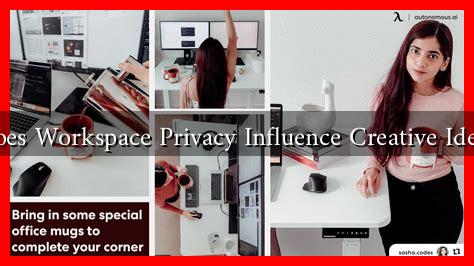-
Table of Contents
Does Workspace Privacy Influence Creative Ideas?
In today’s fast-paced and interconnected world, the workspace has evolved into a dynamic environment that can significantly impact creativity and innovation. One of the critical factors influencing creative output is workspace privacy. This article explores the relationship between workspace privacy and creative ideas, examining how different levels of privacy can either foster or hinder creativity.
The Importance of Privacy in the Workspace
Privacy in the workplace refers to the ability of individuals to work without undue interference or observation. It encompasses both physical and psychological aspects, including the layout of the workspace, noise levels, and the presence of colleagues. Understanding the importance of privacy can help organizations create environments that nurture creativity.
How Privacy Affects Creativity
Research indicates that privacy can have a profound impact on creative thinking. Here are some ways in which workspace privacy influences creativity:
- Reduced Distractions: A private workspace minimizes interruptions from colleagues and external noise, allowing individuals to focus deeply on their tasks. Studies show that deep focus is essential for creative problem-solving.
- Enhanced Comfort: Privacy can create a sense of safety and comfort, encouraging individuals to express unconventional ideas without fear of judgment. This psychological safety is crucial for fostering creativity.
- Encouragement of Reflection: Private spaces allow for moments of solitude, which can lead to introspection and the generation of new ideas. Reflection is often a key component of the creative process.
Case Studies and Examples
Several organizations have recognized the importance of workspace privacy in enhancing creativity. For instance:
- Google: Known for its innovative work culture, Google provides employees with various workspace options, including private pods and quiet rooms. This flexibility allows employees to choose environments that best suit their creative processes.
- Apple: The design of Apple’s headquarters, Apple Park, emphasizes open spaces but also includes numerous secluded areas for employees to retreat and think. This balance between collaboration and privacy has been instrumental in driving innovation.
- Atlassian: The software company has implemented a “quiet zone” in its offices, where employees can work without distractions. This initiative has reportedly led to increased productivity and creative output.
Statistics on Workspace Privacy and Creativity
Several studies have quantified the impact of workspace privacy on creativity:
- A study published in the Journal of Environmental Psychology found that employees with access to private spaces reported a 30% increase in creative output compared to those in open-plan offices.
- According to a survey by Gartner, 74% of employees stated that their work environment significantly affects their creativity, with many citing a lack of privacy as a major hindrance.
Balancing Privacy and Collaboration
While privacy is essential for creativity, it is also important to balance it with opportunities for collaboration. Open-plan offices can foster teamwork and communication, but they can also lead to distractions. Organizations should consider hybrid models that offer both collaborative spaces and private areas.
Conclusion
In conclusion, workspace privacy plays a crucial role in influencing creative ideas. By providing employees with environments that allow for focus, comfort, and reflection, organizations can enhance their creative output. As seen in the case studies of companies like Google and Apple, a thoughtful approach to workspace design can lead to significant improvements in innovation and productivity. Ultimately, finding the right balance between privacy and collaboration is key to fostering a culture of creativity in the workplace.


